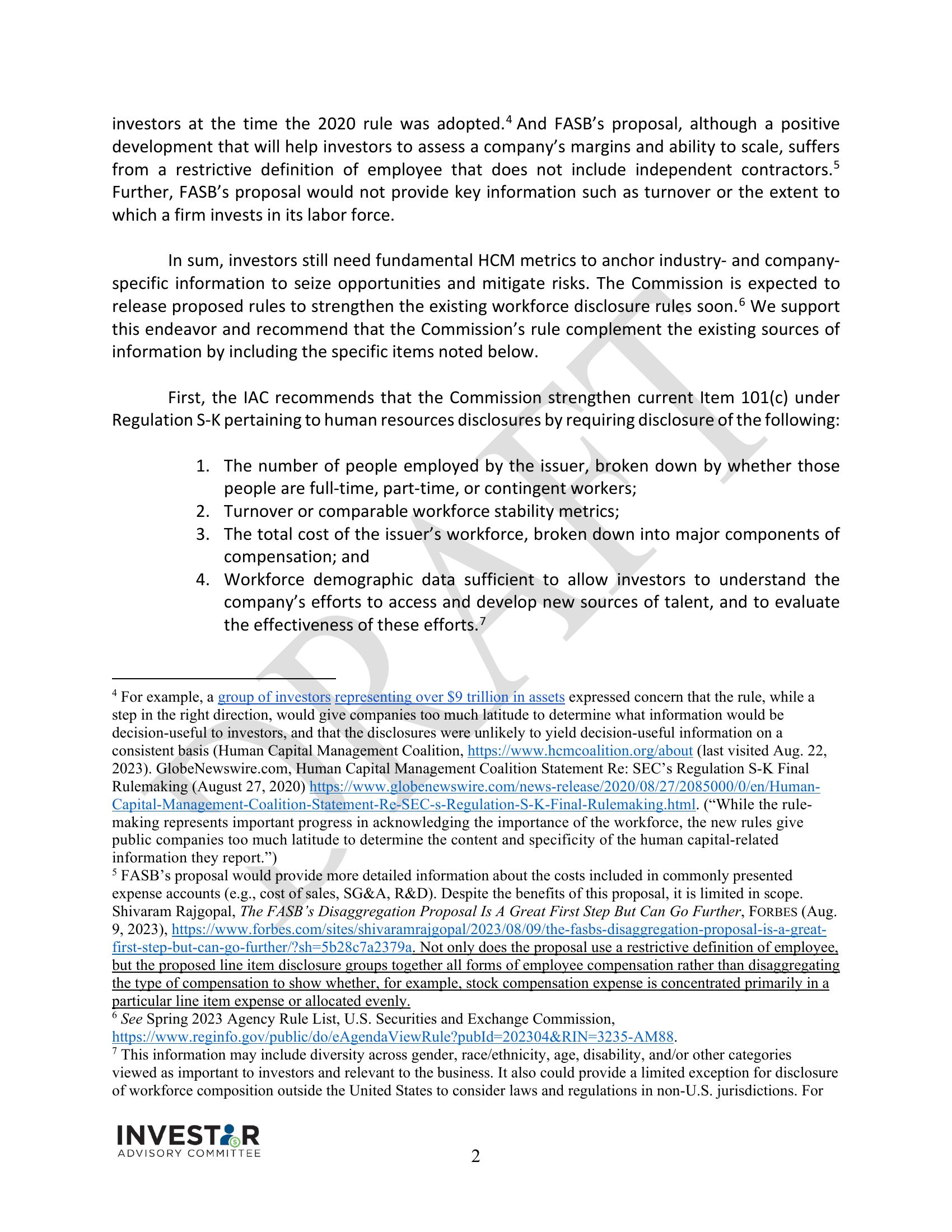Workforce Data Insight Pitch
investors at the time the 2020 rule was adopted.4 And FASB's proposal, although a positive
development that will help investors to assess a company's margins and ability to scale, suffers
from a restrictive definition of employee that does not include independent contractors. 5
Further, FASB's proposal would not provide key information such as turnover or the extent to
which a firm invests in its labor force.
In sum, investors still need fundamental HCM metrics to anchor industry- and company-
specific information to seize opportunities and mitigate risks. The Commission is expected to
release proposed rules to strengthen the existing workforce disclosure rules soon.6 We support
this endeavor and recommend that the Commission's rule complement the existing sources of
information by including the specific items noted below.
First, the IAC recommends that the Commission strengthen current Item 101(c) under
Regulation S-K pertaining to human resources disclosures by requiring disclosure of the following:
1. The number of people employed by the issuer, broken down by whether those
people ar full-time, part-time, or contingent workers;
2. Turnover or comparable workforce stability metrics;
3. The total cost of the issuer's workforce, broken down into major components of
compensation; and
4. Workforce demographic data sufficient to allow investors to understand the
company's efforts to access and develop new sources of talent, and to evaluate
the effectiveness of these efforts.7
4
For example, a group of investors representing over $9 trillion in assets expressed concern that the rule, while a
step in the right direction, would give companies too much latitude to determine what information would be
decision-useful to investors, and that the disclosures were unlikely to yield decision-useful information on a
consistent basis (Human Capital Management Coalition, https://www.hcmcoalition.org/about (last visited Aug. 22,
2023). GlobeNewswire.com, Human Capital Management Coalition Statement Re: SEC's Regulation S-K Final
Rulemaking (August 27, 2020) https://www.globenewswire.com/news-release/2020/08/27/2085000/0/en/Human-
Capital-Management-Coalition-Statement-Re-SEC-s-Regulation-S-K-Final-Rulemaking.html. ("While the rule-
making represents important progress in acknowledging the importance of the workforce, the new rules give
public companies too much latitude to determine the content and specificity of the human capital-related
information they report.")
5 FASB's proposal would provide more detailed information about the costs included in commonly presented
expense accounts (e.g., cost of sales, SG&A, R&D). Despite the benefits of this proposal, it is limited in scope.
Shivaram Rajgopal, The FASB's Disaggregation Proposal Is A Great First Step But Can Go Further, FORBES (Aug.
9, 2023), https://www.forbes.com/sites/shivaramrajgopal/2023/08/09/the-fasbs-disaggregation-proposal-is-a-great-
first-step-but-can-go-further/?sh=5b28c7a2379a. Not only does the proposal use a restrictive definition of employee,
but the proposed line item disclosure groups together all forms of employee compensation rather than disaggregating
the type of compensation to show whether, for example, stock compensation expense is concentrated primarily in a
particular line item expense or allocated evenly.
6 See Spring 2023 Agency Rule List, U.S. Securities and Exchange Commission,
https://www.reginfo.gov/public/do/eAgenda ViewRule?pubId=202304&RIN=3235-AM88.
7 This information may include diversity across gender, race/ethnicity, age, disability, and/or other categories
viewed as important to investors and relevant to the business. It also could provide a limited exception for disclosure
of workforce composition outside the United States to consider laws and regulations in non-U.S. jurisdictions. For
INVESTOR
ADVISORY COMMITTEE
2View entire presentation